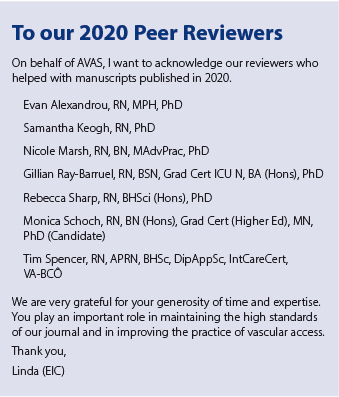Volume 7 Issue 1
From the Editor’s view
Linda M. Verde
For referencing Verde LM. From the Editor’s view. Vascular Access 2021; 7(1):4.
DOI https://doi.org/10.33235/va.7.1.4

We are past the one-year mark into the COVID-19 pandemic and the many changes wrought in efforts to contain this invasive virus are still evolving and still affecting our day-to-day lives in many ways. Wearing masks and keeping our distance from one another has become a new normal, though we look with hope to times when these measures are no longer necessary. As I write this, Australia is in the first phase of the vaccine rollout, a phase that includes many of you as front-line healthcare workers – and rightly so. We are grateful for your continued courage and compassion.
For your reading pleasure, in this issue we give you three articles, all of which have something to do with difficult peripheral vascular access. The differing perspectives and approaches provide a robust look at this widespread problem with ideas for improving your vascular access practice.
In our first article, Nathan Peters and his colleagues look at the impact afterhours has on the experience of difficult peripheral intravenous cannulation. Several factors are considered in light of the predominance of afterhours rosters being filled with junior medical staff. With 22% of insertions deemed difficult, this is a common problem for them, resulting in continued failed cannulation attempts, inefficiencies, and delays. The article offers insight into the added challenges inherent in the current system and how to counteract their effect.
In our second article, Brendan Smith-Hanratty presents five patient cases where a short cannula and the Seldinger wire technique were used for ultrasound-guided peripheral access. In spite of the special training required to use the ultrasound equipment and its limited availability, overall, the technique improved patient satisfaction. See how the results included a 100% first-pass success rate, no complications, no premature device failure, and an above average cannula survival time. From the five cases showing patient experiences, we see the technique works well for short-term vascular access.
Finally, we have a scoping protocol by Priscilla Pather et al. that describes the process for an upcoming literature review regarding the use of point-of-care hand-held ultrasound devices to aid peripheral intravenous cannulation. With hand-held ultrasound devices becoming more popular, this review will seek to provide clarity on the evidence for adoption and use of this technology for improved vascular access.
This journal, Vascular Access, is dedicated to advancing knowledge and best practice in your specialised field. As AVAS President Mark Sutherland exhorts in his message, share your knowledge, experiences, ideas, and research. Publications such as this one provide the evidence upon which to base improved techniques, to inform and raise standards, and to expand the field in which you work, thus making the patient experience better and the professional experience more rewarding. We welcome unsolicited manuscripts at info@avas.org.au and any received before 23 July will be considered for publication in our October 2021 issue. Don’t just think about it, do it!
I always enjoy editing this journal and look forward to each issue for the new information it brings, and I like working with the authors sharing their knowledge. Thank you, authors, reviewers, and editorial and AVAS board members for your contributions.
Stay safe and well,
Linda M. Verde
Editor-in-Chief

Author(s)
Linda M. Verde
Editor-in-Chief
